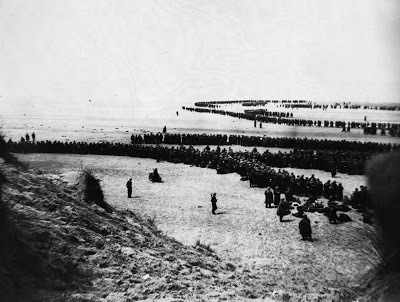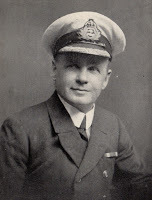The Real Story Behind Mark Rylance’s Character in the Movie Dunkirk
(Warning: spoiler alerts plus the rantings of one irate historian!!)
Christopher Nolan’s riveting screen telling of this epic World War II tale is breaking box office records. Enjoyable as it is, the film does a terrible disservice to one historical character, and left us all the poorer for it.
 History offers few more inspiring military tales than the “Miracle at Dunkirk.” In May of 1940, German forces advancing through France were on the verge of capturing an entire Allied army that had retreated to the coastal town of Dunkirk in a desperate bid to escape across the English Channel.
History offers few more inspiring military tales than the “Miracle at Dunkirk.” In May of 1940, German forces advancing through France were on the verge of capturing an entire Allied army that had retreated to the coastal town of Dunkirk in a desperate bid to escape across the English Channel.The British Admiralty put out the call for every small craft it could find to help stage an emergency evacuation. Yachts, fishing boats, motor launches, tugboats, any vessel that could pull men off the beaches. Despite constant attack by German bombers, this motley fleet rescued more than 300 thousand men and brought them home to England. Winston Churchill called it a “miracle of deliverance.”
As he set about making his movie, Nolan chose not to use actual historical figures. Or at least so he said. "We have fictional characters with fictional names; we're not trying to tell anyone's story here," he told USA TODAY. "Fiction frees you to be able to convey to the audience the greater truth of something. Which is why you end up wanting to combine characters or invent characters."
One of those characters is the quietly heroic Mr. Dawson, played beautifully by Mark Rylance. In fact, however, he is not fictional at all. He’s a very real person with a simple name change. And because of this transparent fictionalization, the real hero gets abslutely no credit in the movie or attendant publicity.
His name was Charles Lightoller. Lightoller owned a 58-foot-power cruiser. Navy officers informed him they were going to commandeer his vessel for the rescue. Lightoller would have none of that. Instead, he captained the boat himself with just his son and one other teenage boy. Determined to rescue every man he could, he crammed more than 130 soldiers on his small motor yacht. His son literally laid them down on top of each other down below, then all over the decks. Once Lightoller had taken aboard every man he could, he piloted the dangerously overloaded vessel back across the English Channel, dodging bombs and bullets all the way.
Here’s an excerpt from Walter Lord’s Book The Miracle of Dunkirk.
“The entire Luftwaffe seemed to be waiting for him. Bombing and strafing, the enemy planes made pass after pass. Fortunately Sundowner could turn on a sixpence, and Lightoller had learned a few tricks from an expert. His youngest son, killed in the first days of the war, had been a bomber pilot and often talked about evasion tactics. The father now put his lost son’s theories to work. The secret was to wait until the last instant, when the enemy plane was already committed, then hard rudder before the pilot could readjust. Squirming and dodging his way across the Channel, Lightoller managed to get Sundowner back to England without a scratch.”
If you’ve seen the movie, this will strike you as instantly familiar.. The “fictional” Dawson’s story tracks Lightoller’s almost perfectly – down to the son in the RAF who was killed, and the evasive maneuver he performed to avoid being sunk by the Luftwaffe. The only difference is that in the movie version, the young boat hand is killed. Nolan didn’t create Mr. Dawson out of his imagination – he brazenly stole the story of Charles Lightoller and changed the name to thinly cover the theft.
I don’t contest his right to do so. Since the time of Shakespeare, and undoubtedly even earlier than that, people making art out of history have used creative license to shape their stories, and literature is the better for it. I have no problem with chosing to use a composite character for the purposes of storytelling. But if you make a movie about a historical subject, and use a real person’s story with only minor changes, why not honor them, and honor the real history by using their name? What a shame that audience’s rooting for Rylance’s character aren’t let in on the secret that he was real.
Here’s what really hurts: In fictionalizing the character, Nolan left out the best part!
 Lightoller’s zeal to rescue as many men as possible was undoubtedly driven by memories of a night at sea nearly 30 years before. It was an unforgettable night: lifeboats heading out half full…cries of distress in the water...despair at not being able to do more.
Lightoller’s zeal to rescue as many men as possible was undoubtedly driven by memories of a night at sea nearly 30 years before. It was an unforgettable night: lifeboats heading out half full…cries of distress in the water...despair at not being able to do more. You see, Charles Lightoller was the second officer on the Titanic. He was one of the rare heroes of that terrible night in April 1912, when 900 people perished in the icy North Atlantic despite his best efforts. In 1940, fate offered him a second chance as a lifesaver . . . and he took it. It is a story sublime in its equal parts of irony, heroism, and heart.
The portion of the movie Dunkirk that tells Mr. Dawson’s story is exciting and moving. Once you know the real story, however, it becomes dishwatery pale, at least to this history lover. Congratulations to Mr. Nolan on making a fine film. But shame on him for replacing real history with an ersatz version that fails to do justice to one of the true heroes of the Miracle at Dunkirk.
Rick Beyer is a New York Times bestelling author, an award-winning filmmaker, and a lifelong histry enthusiast. The story of Charles Lightoller appears in his book The Greatest War Stories Never Told. He is also the author of The Ghost Army of World War II and Rivals Unto Death: Hamilton and Burr.
Thanks to Marilyn Rea Beyer for the editorial oversight!
Published on August 07, 2017 06:23
No comments have been added yet.



